Best Cheese Scones Ever
This easy cheese scone recipe makes the best cheese scones. These savory scones are flaky and light, full of cheese flavor, with the addition of fresh chives.
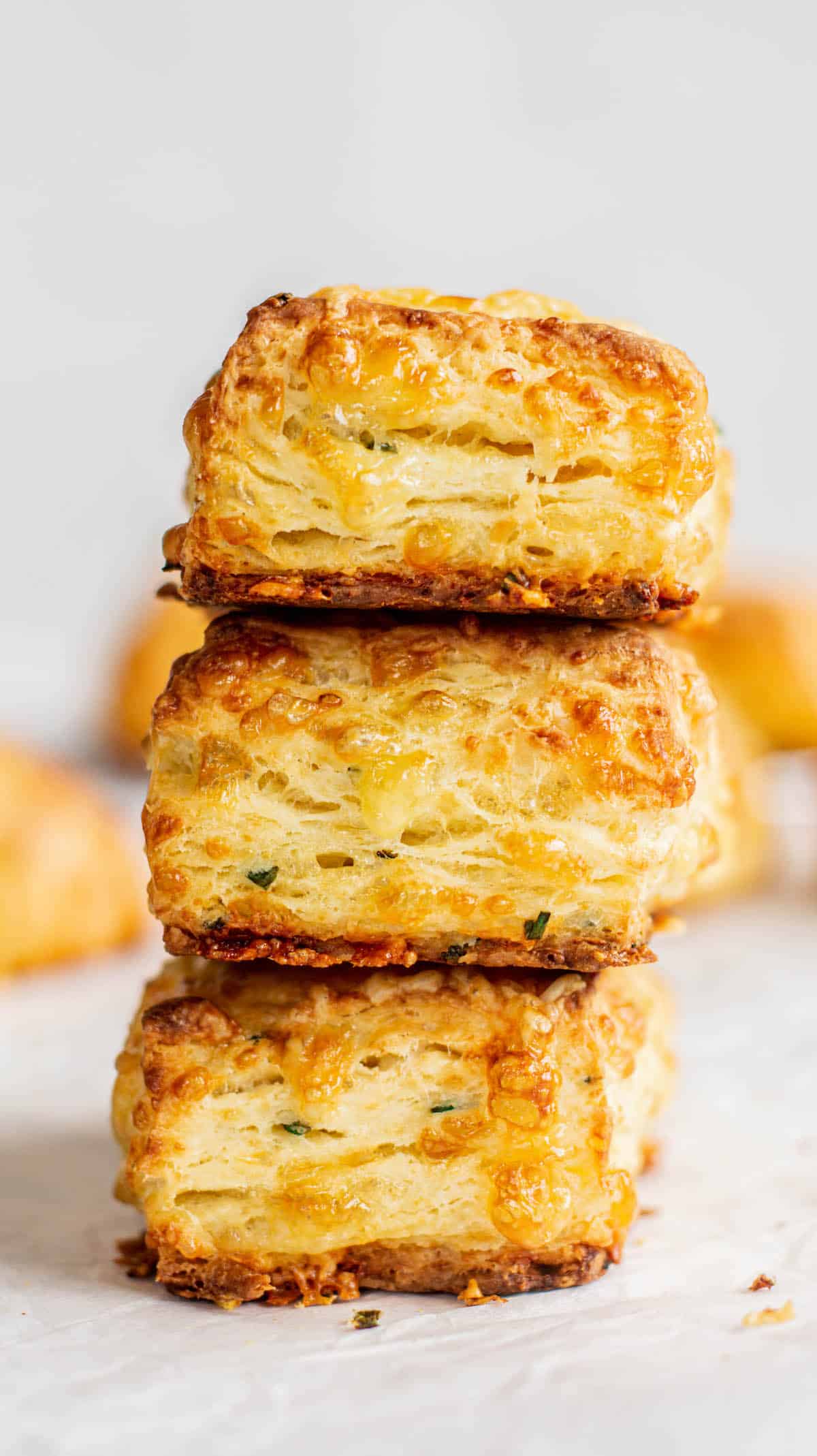
These flaky cheese scones are very much like an American biscuit. They’re tender and fluffy cheese scones, with flaky layers and flecks of flavorful green chives. I think a good scone needs both flakiness and softness. They are based on my popular sourdough cheese scones recipe, but this version has buttermilk instead.
You can use whatever cheese you like in these, but those with a more robust flavor are preferable, such as sharp cheddar cheese.
Alternatively, mix different cheeses to bring flavor, such as a milder Edam cheese with a stronger parmesan. They make such a delicious light lunch or snack.
Ingredients
Find the ingredient amounts for these buttery cheddar cheese scones. in the printable recipe card at the bottom of this post. Here is a rundown of what you will need.
- All-purpose flour
- Baking powder
- Salt
- Butter – This can be salted or unsalted butter.
- Buttermilk – or use whole milk and a little lemon juice or apple cider vinegar. This acid creates tender scones. See the bottom of the recipe card for the substitute.
- Cheese – mature cheddar cheese is great, or choose a mix of different types of cheese. Most goes in the dough, and some is for the top of the scones.
- Chives – The chives bring a lovely mild-onion flavor to the dough and a pretty pop of green. They can be substituted with finely diced onion or shallots.

Flaky scones
The tricks to flaky delicious scones are to keep the butter cold and work the cheese scone dough as little as possible.
Cold butter is cut into the flour using a pastry blender. The pieces become coated in flour, and as they bake and the water in the butter evaporates, the scones rise and becomes light and flaky. You could use a food processor too, but this will often cut the butter too small, and you won’t get great layers.

When the liquid is added, add only what is needed to create a shaggy dough that holds together when pressed. There will be some parts that are dryer than others.
The scone dough doesn’t need to be kneaded. Instead, it’s laminated (like in rough puff pastry.)
This is when you roll the dough out on a lightly floured surface, lift the bottom third and bring it into the middle. Bring down the top third of the dough and fold this over. Push or use a rolling pin to gently roll the rectangle out to flatten it, then repeat the folding. Adding in a few folds achieves extra layers in the dough.
Roll it out once more, then cut it into squares.

Method

Whisk flour, salt, and baking powder in a large bowl. Chop the cold butter into cubes and add it to the dry ingredients.

Use a pastry cutter or fingertips to cut the butter into pea-sized crumbs, ensuring the pieces stay cold and do not melt into the flour.

Stir in the grated cheese and chopped chives.
Make a well in the flour mixture and pour in the buttermilk.
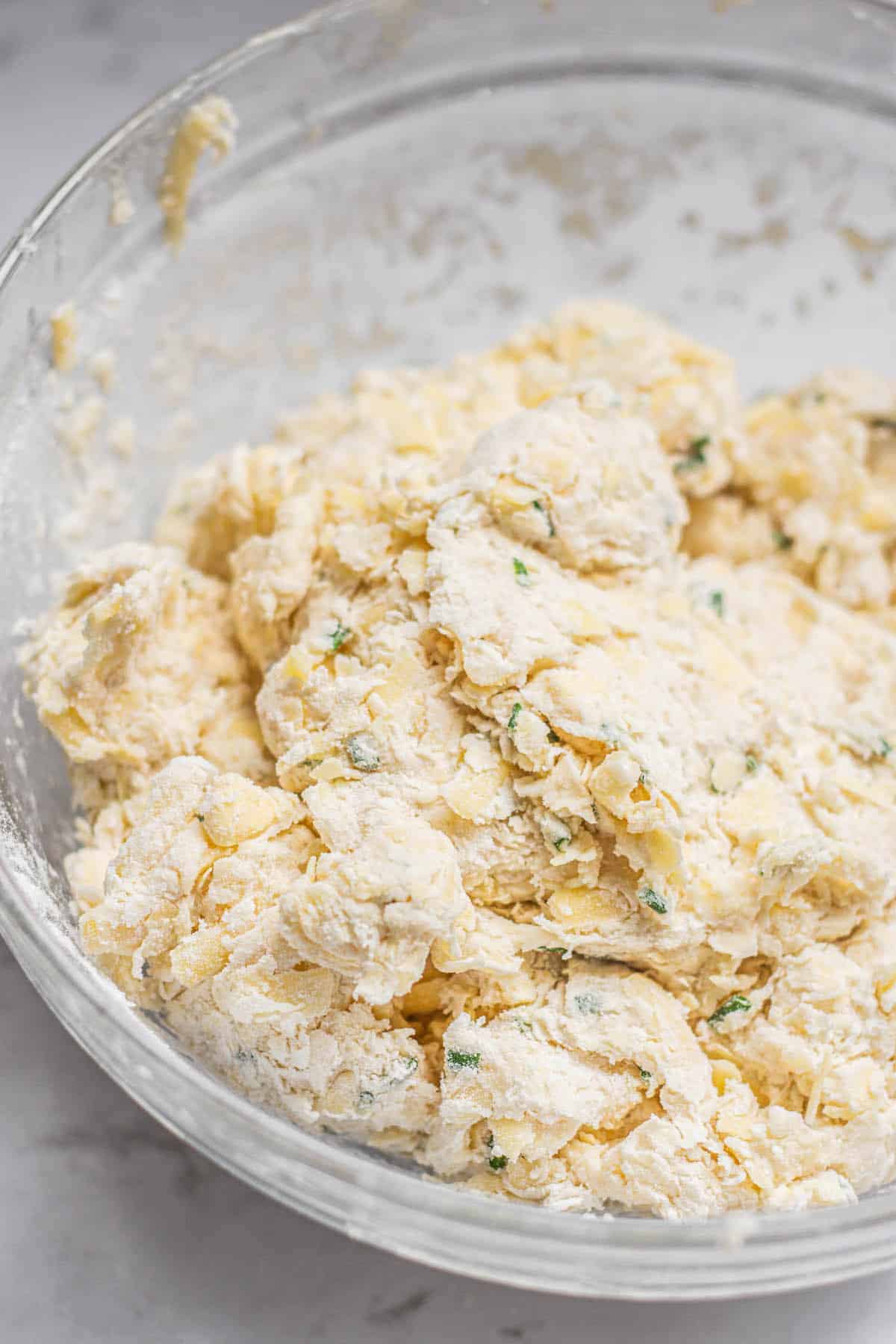
Fold it together using a rubber spatula or wooden spoon, then switch to using your hands to form the dough into a shaggy soft dough ball.
Add in a little milk if the dough is too dry. It can be a little sticky but shouldn’t be wet.
Laminating

Place the dough onto a lightly floured work surface and push it into a ball. Use a rolling pin to roll this out into a rectangle of about 7×10 inches (17cm x 25cm).

Lift the top third of the dough and bring it into the middle. Bring up the bottom third of the dough and fold this over like you’re folding a pamphlet.
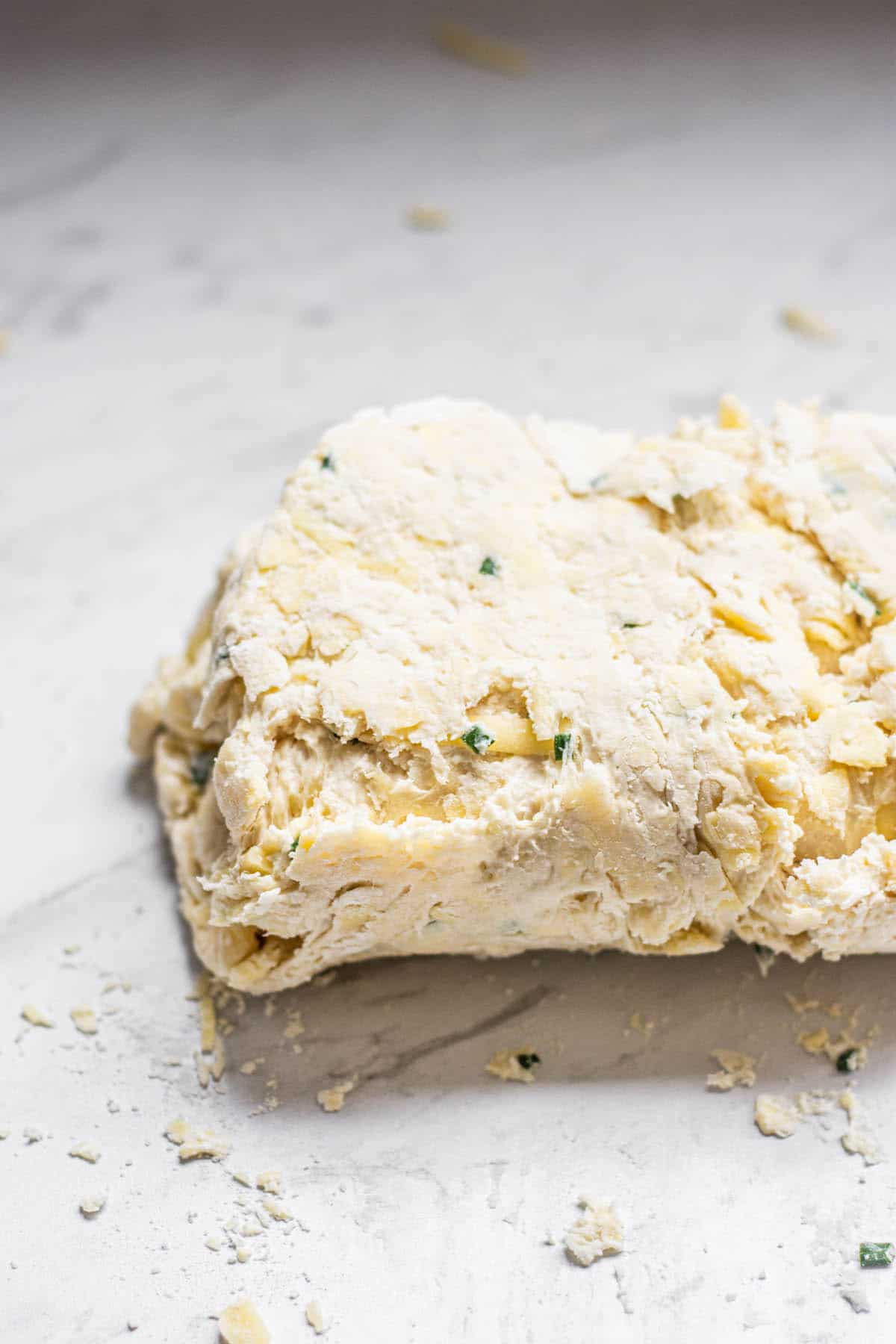
Turn the dough 90° so it’s lengthwise in front of you, then push or use a rolling pin to push it into another 7×10 inches rectangle. Fold it up once more.

Turn the dough 90° again so it’s lengthwise in front of you, and roll one last time into a 7×10 inches (17cm x 25cm) rectangle.
Use a sharp knife to cut the dough into eight pieces for large scones or ten pieces for smaller scones.
Place the scones in the refrigerator while you preheat the oven to 425°F/220°C.

Baking
Line a baking tray with parchment paper. Place the cold scones on the lined baking sheet. Brush the tops of the scones with milk and top them with the remaining cheese. Bake for around 15 minutes until golden brown. Let them cool on a wire rack.
Serving
Serve the cheddar scones warm for afternoon tea, with a pat of butter or a slice of cheese and chutney. They’re also delicious with a bowl of soup!
Cooled scones can be stored in an airtight container at room temperature for up to 4 days or frozen for up to three months. Re-warm them in the microwave.
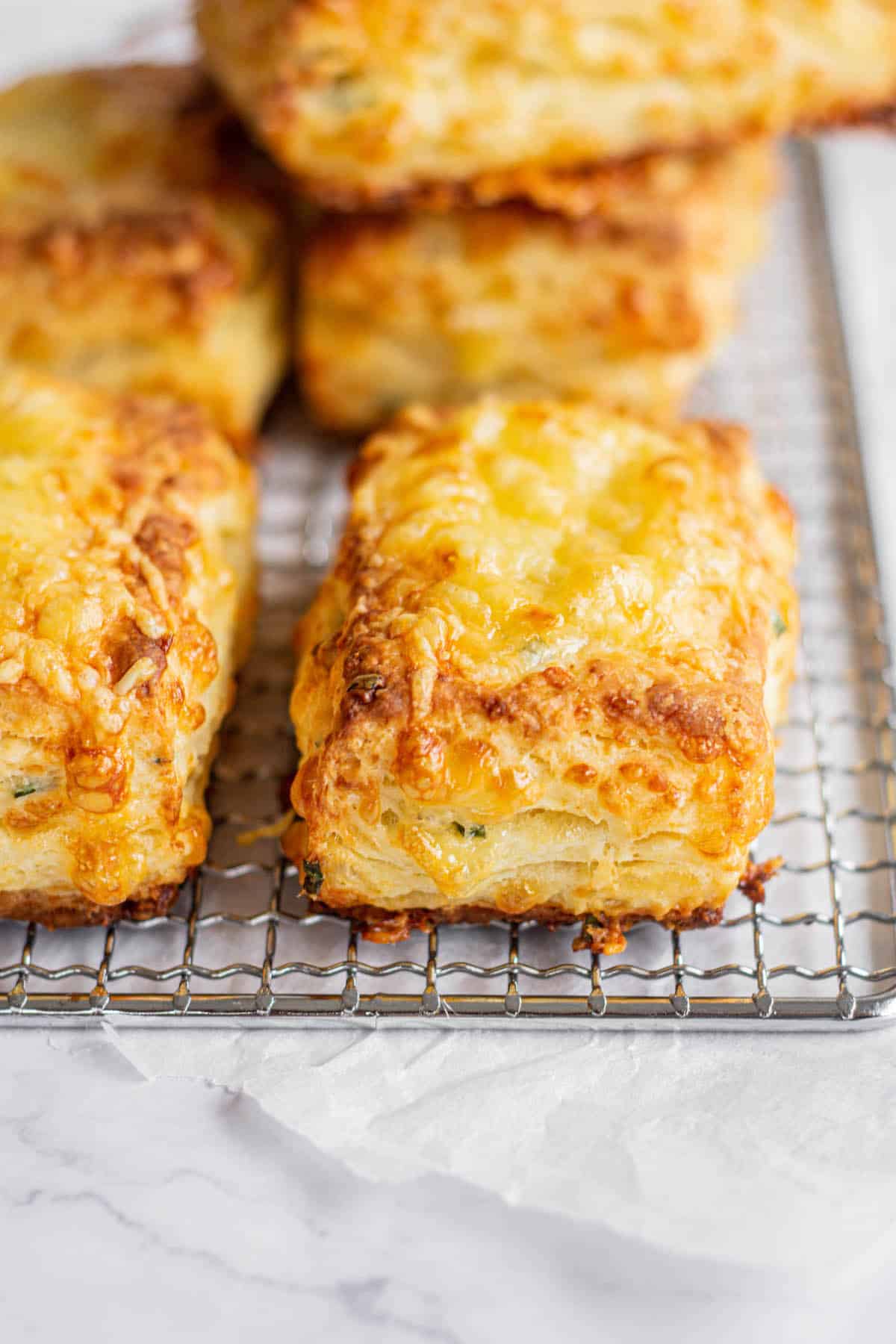
Additions
This is a versatile dough; you can add different things to change the flavors. Try:
- Add in a little garlic powder, black pepper or mustard powder
- Chopped jalapenos or a pinch of cayenne pepper to bring spice
- Diced bacon or leftover ham
- Diced bell pepper or dollop in sweet chutney
- Pesto can be added in too, like basil pesto or sundried tomato pesto.
FAQS
Essentially yes. I’ve always called them cheese scones, and that’s what they’re known as in NZ and AUS, but they’re the same as an American cheese biscuits.
The key to flaky and tender scones is using cold butter, limited liquid, and gently handling the dough. Overworking the dough and hydrating it too much can activate gluten development in the flour. This can make the scones tough. Also, using a folding technique can create layers in the dough, contributing to the flakiness.
Yes, you can prepare the dough, cut it into scones, and refrigerate for several hours or overnight. You can also freeze the unbaked cheese scones on a baking sheet before transferring them to a freezer bag for storage. Bake them directly from the freezer, adding a few extra minutes to the baking time.
These cheese scones bake at a high temperature for a short period. This allows them to rise quickly and become fluffy while becoming a nice golden color on top.
Definitely! You can use ingredients like cooked bacon bits, garlic, cayenne pepper, or other herbs and spices.
mature cheddar cheese is great, or choose a mix of different types of cheese. Most goes in the dough, and some is for the top of the scones.
Related reading
If you enjoyed these fluffy cheese scones, you might like these recipes too!
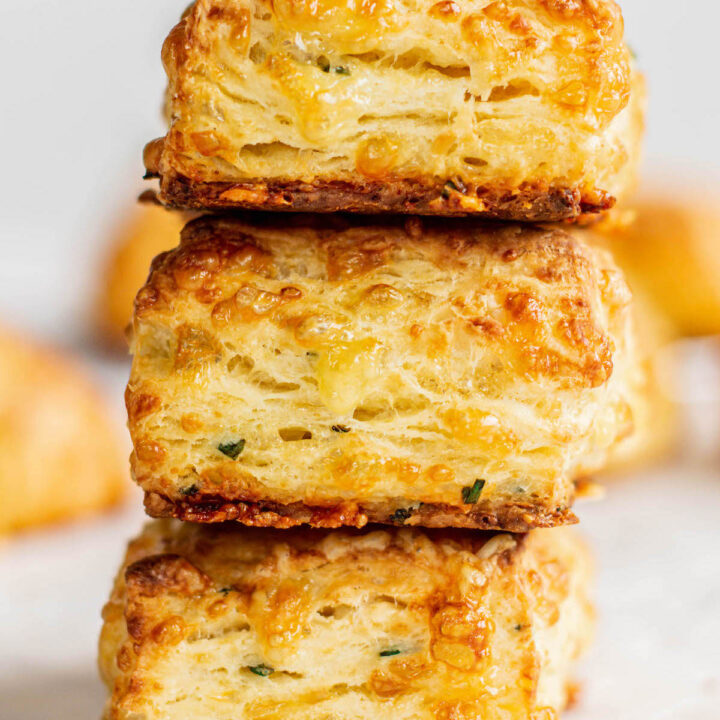
The Best Cheese Scones
This easy cheese scone recipe makes the flakiest, lightest savory scones. They're full of cheese flavor, with the addition of fresh chives.
Ingredients
- 345g (2 ¾ cups) all-purpose flour
- 1 tablespoon baking powder
- 1 teaspoon salt
- 113g (½ cup) unsalted butter, cold and cubed
- 200g (7oz) grated cheese*
- 2 tablespoons fresh chives, finely chopped
- 225g (8oz) buttermilk, plus more if needed
Topping
- Milk for brushing
- Grated cheese
Instructions
- Whisk flour, salt, and baking powder in a large bowl. Chop the cold butter into cubes and add it to the dry ingredients. Use a pastry cutter or fingertips to cut the butter into pea-sized crumbs, ensuring the pieces stay cold and don’t melt into the flour.
- Stir in the grated cheese and chopped chives.
- Make a well in the flour mixture and pour in the buttermilk. Fold it together using a rubber spatula or wooden spoon, then switch to using your hands to form the dough into a shaggy soft dough ball.
- Add in a little milk if the dough is too dry, but it shouldn't be wet or too sticky.
Laminating
- Place the dough onto a lightly floured surface and push it into a ball. Use a rolling pin to roll this out into a rectangle of about 7x10 inches (17cm x 25cm). Don't make it too long, you want to work the dough as little as possible.
- Lift the top third of the dough and bring it into the middle. Bring up the bottom third of the dough and fold this over like you're folding a pamphlet.
- Turn the dough 90°, then push or use a rolling pin to push it into another 7x10 inches rectangle. Fold it up once more.
- Turn the dough 90° again and roll one last time into a 7x10 inches (17cm x 25cm) rectangle.
- Use a sharp knife to cut the dough into eight pieces for large scones or ten pieces for smaller scones.
- Place the scones in the refrigerator while preheating the oven to 425°F/220°C.
Baking
- Line a baking sheet with parchment paper. Place the cold scones on the prepared baking sheet.
- Brush the tops of the scones with milk and top them with a bit of cheese. Bake for around 15 minutes until golden brown.
Notes
Cheese - You can use whatever cheese you like in these scones, but those with a stronger flavor, such as cheddar cheese, are preferable. Alternatively, mix different cheeses to bring flavor, such as a milder Edam cheese with a stronger parmesan.
Cup sizes - The cup sizes given are US-size cups. Note that these are smaller than metric. For best results, use a kitchen scale and measure in grams.
Buttermilk substitute - You can substitute buttermilk by mixing 225g milk (1 cup minus 1 Tbsp) with 15g (1 tbsp) lemon juice or apple cider vinegar. This makes slightly more than the buttermilk, so you may only need some.
Make ahead - Prepare the dough, cut it into scones, and refrigerate for several hours or overnight. You can also freeze the unbaked cheese scones on a baking sheet before transferring them to a freezer bag for storage. Bake them directly from the freezer, adding a few extra minutes to the baking time.
Nutrition Information:
Yield: 10 Serving Size: 1Amount Per Serving: Calories: 297Total Fat: 16gSaturated Fat: 10gTrans Fat: 0gUnsaturated Fat: 5gCholesterol: 45mgSodium: 533mgCarbohydrates: 28gFiber: 1gSugar: 1gProtein: 9g
This is an informational estimate only. I am not a certified Dietitian or Nutritionist






My mouth is salivating. I absolutely obsessed with any type of baking that involves CHEESE, I’m right there. But its 1am Wednesday to late to bake but later on today they will be made they look so incredibly flaky and cheesy and butterfly. OMGosh can’t wait…😋😋😋
Hope you love them 😃
These are so tasty! My daughter thinks these are the best cheese scones in the world. Will be making these again.
So happy you loved them!!
How are these scones if there’s no egg and they’re flaky? Aren’t these more like biscuits? (USA kind)
Yeah they’re like USA biscuits and NZ style scones 🙂
Oh nice. Must be one of those things like crisps being chips and cookies being biscuits. Thanks! Didn’t know NZ had their own terms too.
Hi Elien,
Would the temprature for your scones 220c ordinary bake or fanbake?
Ordinary oven 🙂
Wow best scone recipe ever and family enjoyed them as well. I’ll be keeping this recipe for sure thanks so much for sharing it 🙂
Hi there. I don’t have a pastry cutter. What can I use instead?
You can chop it into small cubes with a knife and then use your fingers to rub the butter in 🙂
I will not be using any other cheese scone recipe from now onwards. These were stunning – light, flaky, and with a lovely balanced cheesy flavour and oh, so buttery. I had to control myself after two. Only addition I made was adding an egg in with the ‘well’ with the buttermilk. Thank you for sharing your recipe.